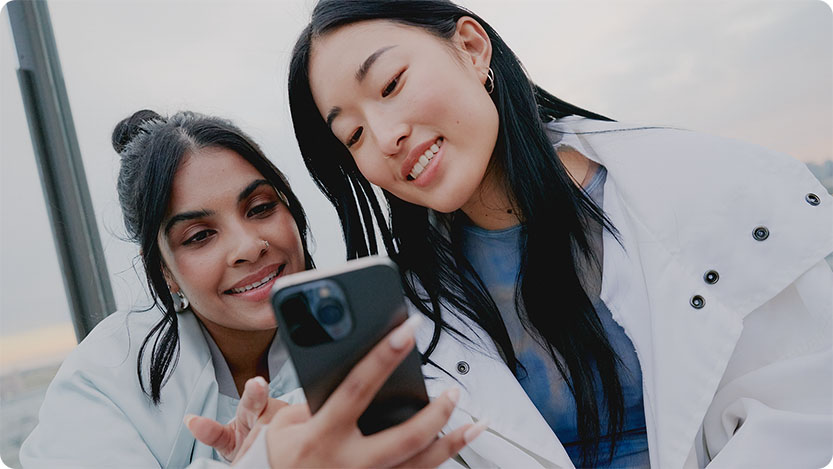Blog post
Transforming audience engagement with generative AI

Consumers today have clearly expressed a desire for personalized, streamlined digital engagements. A full generation into the digital journey, generative AI is making this possible. We are entering an era where engagement with content is being redefined, moving away from the overwhelming clutter of digital noise and toward highly curated, hyper-personalized, and deeply relevant experiences.
At Microsoft, we are using generative AI to make our products more helpful, personal, and enjoyable for everyday life and work.
Microsoft Copilot, the everyday AI companion, is at the center of this transformation. With consumers, Copilot has seen strength in engagement and usage, with the number of conversations more than doubling year-on-year. And in that same period, consumer journeys that include both Microsoft Copilot and traditional search have grown 85%, and this number is even higher on mobile devices, increasing over 2.5x.1
Microsoft has been pioneering advertising on generative AI experiences, including Search ads on Microsoft Copilot, since its release in 2023. Our learnings since launch have been encouraging.
For advertisers, Microsoft Copilot is enhancing engagement across various ad types, including Vertical ads, Multimedia ads, Responsive Search ads, and Product ads. Ads on Copilot have click through rates that are 69% stronger, and conversion rates are 76% higher when comparing lower funnel ad types to traditional search.2
A new user-centric advertising experience
The next phase of Microsoft Copilot represents a new step on this journey, reimagining what user-centric advertising means. Our goal with Copilot is to simplify the experience of the digital world while making it more personal. Advertising plays an important role in accomplishing this.
The updated Microsoft Copilot delineates organic and sponsored conversations better and introduces ads in a way that complements Copilot’s simplified layout. Consumers will start to notice the following changes to ads in Copilot:
- Ads in Copilot will be featured in a new, streamlined experience below Copilot’s organic response. There will be an even higher focus on the relevancy of the information displayed, with fewer ad annotations and extensions shown because we are more effectively able to identify what will be relevant and useful.
- To make this possible, ads will be triggered considering the whole conversation within a single session and not just the last prompt. Before an ad block is shown, Copilot will share with the user how the following ad section connects to their conversation. For now, we are calling this feature ad voice, a summary that acknowledges the organic response and introduces the message from advertisers, making it more inviting and natural to the conversation.
This experience begins roll out this month on copilot.microsoft.com and will expand over time to our updated apps on Android and iOS as well as Copilot experiences in Bing and Edge.

This refreshed experience highlights the simpler design and the introduction of ads through ad voice and will extend to new and innovative ad experiences over time.
Our work toward creating AI companion experiences extends from Copilot far into our ecosystem to services like Bing, Microsoft Edge, and MSN which will also be more personalized, visual, cohesive and useful experiences than ever before. For example, Bing’s generative search goes beyond simply finding an answer, instead using AI to dynamically generate curated, relevant answers. We began deploying these solutions across Bing on October 1 and continue to explore new ways in which consumers can more easily trigger Bing generative search for informational queries. To explore the topic of generative search, anyone can simply search “Bing generative search” to choose from a selection of demo queries.
Looking at the future of more engaging and useful digital experiences, we are also charting a course forward in how we are thinking about conversational advertising and adapting more ads to the specific context of each user and each moment. This will be achieved through more immersive ads that showcase product details in an increasingly interactive way and inform about deals from brands people follow. We expect that brands will create their own copilots--what we’re thinking about as brand voice--enabling Copilot to bring them to the conversation to aid consumers looking for product recommendations. While we are still early on this journey, it’s clear that the future holds tremendous potential for how brands connect with consumers.
Empowering advertisers with new generative AI tools
Microsoft’s goal is to make AI useful in people’s everyday lives, both at home and at work. From Bing and Edge to Windows to Dynamics 365 and Azure, we’re working to redefine how people interact with all our products, and this includes our advertising platforms.
With Copilot in the Microsoft Advertising Platform, we’re helping advertisers unlock productivity, unleash creativity, and uncover insights - ultimately uplevelling performance. Over the last year, Copilot has been helping users save time and augment creativity by assisting in writing or refining new marketing messaging. Additionally, using Copilot to compose images, videos, and banners has improved and multiplied creative asset variety, leading to improved optimization and personalization opportunities.
Today, we continue to innovate Copilot in the Microsoft Advertising Platform in service of our customers’ top needs, by announcing two new capabilities:
1. Diagnostics: We hear from advertisers that quality assurance tasks, like ensuring campaigns launch properly and are running as expected, are time consuming. With this new diagnostics feature, Copilot in the Microsoft Advertising Platform gives users an extra set of eyes to inspect campaign setup, assess account health, diagnose where attention is needed, and propose what to do next, all activated via simple conversational engagement. The diagnostics feature begins piloting this month and is the latest advancement in our commitment to saving advertisers’ time in the campaign management process while giving them peace of mind.
2. Performance snapshot: Advertisers have also shared a clear need for quick updates on how their campaigns and accounts have been performing since a prior point in time – since they last logged in, since last week, etc. With our new performance snapshot feature, an advertiser can use natural language to ask Copilot in the Microsoft Advertising Platform to obtain an account or campaign-specific performance overview with a summary of key insights, trends, and anomalies. This feature begins piloting this month, gradually rolling out to all regions where Copilot in the Microsoft Advertising Platform is available.
We will continue to innovate towards our vision of making it easier and faster for advertisers to access the information and insights they need by just asking Copilot in the Microsoft Advertising Platform.
These new capabilities were developed in direct response to feedback in listening sessions with advertisers of all sizes and across verticals and geographies, and we have such gratitude for the partnership in co-creating the future of generative AI in advertising. One of these clients is dentsu, an early adopter of Copilot in the Microsoft Advertising Platform.

We continue to expand access to Copilot in the Microsoft Advertising Platform’s powerful features for advertisers:
- Copilot in the Microsoft Advertising Platform’s capabilities are now live in 15 languages: English, French, German, Italian, Japanese, Portuguese, Simplified Chinese, Spanish, Traditional Chinese, Dutch, Filipino, Korean, Russian, Thai, and Turkish.
- Advertisers using Microsoft Advertising Editor and Microsoft Invest now also have access to Copilot’s asset recommendation and asset creation features. Microsoft Advertising Editor users can unlock productivity and unleash creativity for their Performance Max, search, and Native ads, while Microsoft Invest users can now use these features for Native ads.
There is so much more to come. We will continue to build more capabilities for video and image generation, including the option to directly comprehend branding guidelines from advertisers. On the insights front, we plan to enable additional advanced campaign diagnostics and performance features across multiple campaign types. And finally, we will enable agency and technology partners to leverage our generative AI capabilities via API to enhance their own tools.
The time is now
We have come a long way since releasing ads in Copilot and pioneering generative AI capabilities for advertisers inside Copilot in the Microsoft Advertising Platform. With todays’ announcements and our vision for a steady drumbeat of continued innovation, we invite advertisers to work with us as we drive the future together. Actionable gains are within your reach right now as we enter the shopping season:
- Copilot in the Microsoft Advertising Platform can help save precious time during this busy holiday season, suggesting more occasional creative assets for advertisers to consider, refine, and adopt what they like. The better the variety of creative assets, the better the chances to increase relevance and personalization in your message to attract seasonal shoppers.
- Performance Max offers advanced AI optimizations that provide agility to identify opportunities in the context of a conversation, increasing the potential to be featured as part of Copilot conversations in a way that’s helpful to consumers. Our data shows that Performance Max boosts Product ads impressions on Copilot by 5x and improves click through rate (CTR) by 2x in comparison to traditional search. Similar data is observed across Performance Max ad types, including Multimedia ads and Responsive Search ads.
We will continue to listen to advertisers, of all sizes and AI maturity, as we co-create these generative AI tools around their needs. We can’t wait to collaborate and innovate on what’s next. In the meantime, check out the Copilot in the Microsoft Advertising Platform page for more information.
[1] Microsoft first party data | August 2023 - August 2024
[2] Microsoft first party data | June 2024 - August 2024
Your input makes us better
Take our quick 3-minute survey and help us transform your website experience.




